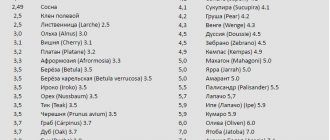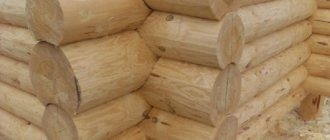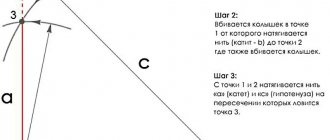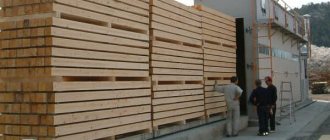The transition to alternative energy sources forces us to pay attention to wood. This is what our ancestors used to heat their homes and cook food. Stoves, fireplaces, solid fuel boilers - all these devices require wood, namely firewood. But all plants are different, and trees, having different structures and chemical compositions, differ in such characteristics as calorific value, weight, density, and humidity.
How many cubic meters of firewood are in a car trailer?
So, if the internal dimensions of the trailer
are: length - 2.05 m, width - 1.1 m, height 0.3 m, its cubic capacity will be equal to: 2.05 × 1.1 × 0.3 = 0.68 cubic meters.
Interesting materials:
How to get glass in raft? How to get algae in raft? How is coal mined in the Pechora Basin? How to get to the Salaryevo bus station? How to get to the gardener from Lyublino? How to get by train from Ukraine to Georgia? How to prove your relationship with your sister? How long do you have an intestinal infection? How long do powder eyebrows last? How long does a fever last for a sore throat while taking antibiotics?
2021
Scroll up
How much does firewood weigh?
How to determine the weight of 1 cube of firewood ? Does it matter what kind of firewood you buy, freshly cut or dried? Knowing the specific gravity, humidity and other characteristics of wood will help you deal with this.
More than 200 species of trees and shrubs grow in our country. They all burn differently, some faster, others slower, some give off a lot of heat, some less. When choosing wood for the firebox, it is better to focus on middle-aged wood; do not choose too young or too old. They burn for the longest time and produce the most heat.
Also, the amount of heat released directly depends on the density and dryness of the firewood. Wood with a moisture level of 15–20% is considered the most suitable for sending to the firebox, and in a freshly cut tree the moisture level is not less than 50%. Some of the heat will be spent on evaporation of water, so the efficiency of wet firewood is much lower. And the weight of dry firewood is significantly lower than wet firewood.
The weight of wood depends on:
- structure of wood cells, moisture content in them,
- wood density,
- parts of the plant (the heaviest parts are the branches, the lightest are the base of the trunk),
- content of salts and resins.
The weight of firewood can be determined empirically, that is, simply weigh a small piece of wood of a certain volume and, through simple calculations, find out its density (the ratio of mass in kilograms to volume in m3). But such a procedure is not convenient to carry out in all cases.
Tables of average wood weights will help make calculations simpler.
The values are given conditionally for a material humidity of 15 – 20%. Interestingly, changing the moisture content of a tree does not change its density, although it greatly affects the specific gravity value. Table of some reference values for wood density and weight of firewood during loading
| Wood species | Specific gravity g/cm3 | Specific gravity kg/m3 | Loading weight of firewood kg/m3 |
| Ash, beech | 0,68 | 650 – 750 | 480 |
| Birch | 0,65 | 620 – 650 | 450 |
| Oak | 0,71 | 650 – 800 | 470 |
| Larch | 0,66 | 580 – 635 | 420 |
| Pine | 0,52 | 480 – 520 | 360 |
| Spruce | 0,45 | 420 – 450 | 330 |
| Acacia | 0,69 | 650 – 750 | 460 |
| Elm | 0,65 | 620 – 660 | 440 |
| Aspen | 0,48 | 460 – 550 | 350 |
We weigh
To begin with, we placed 1 cubic meter of birch firewood in a woodpile, just like we deliver it to our customers.
In the photo below, the volume that we will measure is outlined in red. On the left and right, we used the bagged firewood as a support so that our woodpile would not fall apart while we were measuring it.
Next, we take measurements to make sure that there is at least one stacked cubic meter of firewood in our woodpile.
The length and height of the woodpile are approximately the same, but there are discrepancies in the length of the logs due to hand sawing and splitting. The length of the logs varies from 42 to 48 cm, sometimes up to 52 cm, much more often in the range of 45-48 cm. After measuring several times, we get an average length of 45 cm.
Woodpile length 206cm, height 110cm. We calculated the length and height of the woodpile according to the minimum values. For example, the height of the woodpile turned out to have a slight difference, from 115 to 110 cm. Next, we convert the numbers into meters and multiply.
How and with what will we weigh?
To weigh our volume of firewood, we decided to put the firewood into bags and weigh them with ordinary scales. Then, add up the weight of each bag and get the total weight of 1 folding cube.
Add and get the result
As a result, we got 25 bags of firewood, the average weight of each bag
23 kg. And the total weight is 566.5 kg. Those. even a little more than we originally should have received.
Number of kilowatts in 1 tree
For the calculation, firewood with 20% humidity was considered when burned in a stove with 75% efficiency.
| Diameter in centimeters | Height in meters | ||||
| 10 | 15 | 20 | 25 | 30 | |
| 10 | 76 | 108 | 138 | ||
| 15 | 168 | 239 | 311 | 383 | |
| 20 | 283 | 411 | 541 | 670 | 800 |
| 25 | 417 | 616 | 818 | 1021 | 1225 |
| 30 | 850 | 1139 | 1430 | 1726 | |
| 40 | 1369 | 1883 | 2402 | 2921 | |
| 50 | 2721 | 3527 | 4337 | ||
How many trees are needed to produce 12,000 kW
The table shows the number of trees required to produce 12,000 kW. Calculations assume 20% moisture when burning in a 75% efficient oven.
| Diameter in centimeters | Height in meters | ||||
| 10 | 15 | 20 | 25 | 30 | |
| 10 | 158 | 111 | 87 | ||
| 15 | 72 | 50 | 39 | 31 | |
| 20 | 42 | 29 | 22 | 18 | 15 |
| 25 | 29 | 19 | 15 | 12 | 10 |
| 30 | 14 | 11 | 8 | 7 | |
| 40 | 9 | 6 | 5 | 4 | |
| 50 | 4 | 3,5 | 3 | ||
Capacity 131
The next car is called ZIL 131. It is an all-terrain vehicle with all-wheel drive. It was intended for the army.
https://www.drovavoz.ru/drov-v-zile.html - link
| "Gazelle" | |
| Length: 2.8-3.2 m (extended options up to 4.5 m exist) Width: 1.8 - 1.9 m Height: 1.7 - 2 m Volume: 9-11 m3 Load capacity: 1.5 - 1.7 tons | Based on their main consumer qualities (tonnage, volume, overall dimensions), various models of domestic and imported trucks can be classified as Gazelle class vehicles. The cargo compartments of these vehicles may differ slightly in overall dimensions and, accordingly, volumes. Cars of this class are actively used on intracity and intercity routes of short and medium range (500-700 km). Technical characteristics allow us to guarantee a fairly high average speed (up to 100 km/h) and the cabin layout provides space for one or two passengers (forwarders). The tilt version of the cargo compartment suggests the ability to open the cargo compartment and get an open cargo compartment. The car can be equipped with fastening belts and other additional equipment (elevator, hard sides). |
| "ZIL-Bychok" | |
| Length: 3.7 m Width: 2.1 m Height: 2.2 m Volume: 17 m3 Load capacity: 3.5 tons | Based on their main consumer qualities (tonnage, volume, overall dimensions), various models of domestic and imported trucks can be classified as ZIL-Bychok class vehicles. The cargo compartments of these vehicles may differ slightly in overall dimensions and, accordingly, volumes. Cars of this class are actively used on intracity and intercity routes of short and medium range (500-700 km). Technical characteristics allow us to guarantee a fairly high average speed (up to 80 km/h); a small axle load allows this vehicle to drive unhindered in areas with restrictions on the entry of freight vehicles |
| "ZIL" | |
| Length: 3.5 - 4 m Width: 2-2.3 m Height: 2.45 m Volume: 14-21 m3 Load capacity: 5 tons | Based on their main consumer qualities (tonnage, volume, overall dimensions), various models of domestic and imported trucks can be classified as ZIL class vehicles. The cargo compartments of these vehicles may differ slightly in overall dimensions and, accordingly, volumes. Cars of this class are actively used on intracity and intercity routes of short and medium range (500-700 km). Often used for transporting personal belongings and moving. |
Number of firewood in terms of load capacity
The old type tractor cart is capable of lifting 4 tons of cargo. According to the villagers, they transport 6 tons.
Knowing the average weight of various types of wood with natural moisture, you can calculate how many cubes are in a tractor trailer. Provided it is overloaded.
With overload, the tractor cart includes:
- 10 cubes of birch wood;
- 8 cubic meters of oak;
- 11.2 cubic meters of aspen dies.
The calculation is made on the condition that the firewood is chopped and stacked in the body.
The new tractor cart marked 2PTS-4.5 has a load capacity of 4.5 tons. We do not have data on how much this model can be overloaded. But since the design has not changed radically, we will assume that it will withstand an overload of 2 tons.
The carrying capacity of the 2PTS-4.5 cart is close to the previous model. This trailer will accommodate 0.8 cubic meters more firewood.
- Birch firewood can fit 10.8 m3;
- Split alder fits 13.8 cubic meters;
- Oak trees will fit 8.8 cubic meters;
- There will be 12 cubic meters of aspen firewood.
https://www.drovavoz.ru/drov-v-telege.html - link
How many cubic meters of firewood are there in the Lawn?
Determining the volume of firewood neatly stacked for storage is quite simple. It is much more difficult to find out how many cubic meters are in the car that was brought to you. Let's consider, for example, how many cubic meters of firewood are in a GAZ 53.
First, we must find out the full volume of the car body. The standard Lawn has a body volume of approximately 4.8 cubic meters. If you see that the firewood is loaded without a slide, then its volume clearly cannot be higher.
There are body modifications with silo (extended) sides, whose volume is increased by 1.5 - 2 times.
In addition to the volume of the body, the laying method influences how many cubes of firewood are in the lawn. More precisely, the presence of stacking: if the firewood is neatly stacked, then it occupies almost the entire volume of the body, but if it is dumped in bulk, then there is a lot of free space between them. There is a special coefficient for converting the bulk volume into the volume of folded cubic meters. The coefficient depends on the length of the log. For example, for a log of a quarter meter the correction factor is 0.8, and for a log of 3 quarters of a meter it is already 0.73.
This means that 4 cubic meters of firewood with an average length of 25 cm, brought in bulk, will turn into 3.2 cubic meters after stacking.
Is it possible to fit 6 cubic meters of firewood in a GAZ 53?
As we have already said, if the car has extended sides or if you load the body with a significant slide, then it is possible. This becomes more likely if the firewood is loaded by stacking rather than in bulk. In the latter case, even in an 8-cube body there may be 2-3 cubic meters of firewood.
Let's consider how many cubic meters of firewood are in the GAZ 66. The volume of the body of this car may vary depending on the type, but, on average, it is 3 - 4 cubic meters, without extended sides. This is also the maximum volume of transported firewood, taking into account normal stacking along the sides.
So, to estimate the volume of firewood brought, you need to know the volume of the body and the method of stacking the firewood. The situation becomes somewhat more complicated when loading “heaped”, but its volume can also be calculated by dividing the firewood into 2 conventional geometric shapes:
- Body parallelepiped along the sides;
- Separate slide. For ease of counting, you can even level the slide, making it flatter.
By adding the volume of both figures (obtained by multiplying the length, height and width) we get the approximate volume of firewood.
https://samanka.ru/skolko-kubov-drov-v-gaz-53.html — link
Body dimensions of GAZ 53 - 3740*2170*680 mm. Multiplying these indicators, we get a volume of 5.2 cubic meters. This is the volume of the factory body along the edges of the sides. Load capacity - 4 tons. Of course, the cubic capacity of the body can be easily increased by making stripes. Craftsmen increase the cubic capacity by 1.5, 2, or even 2.2 times. Usually, stripes of the same height are made on factory sides. Then the body volume will be about 11 cubic meters.
What determines the mass of a tree?
The weight of firewood is a variable value and depends on many factors and conditions. First of all, it depends on the type of tree - birch is almost one and a half times heavier than poplar, which can be explained by different densities.
The main indicators are:
- the amount of impurities and substances in wood fiber (resin, salt, liquid);
- humidity
On a note! Dry birch firewood has a moisture content of 15%, while wet birch firewood has a moisture content of 50%, this is almost a 20% difference in the mass of one cubic meter!
- part of the tree - the branches are the heaviest, then the trunk, then the roots - they are the lightest.
The age of the tree and the method (density) of laying it in a cube also matter. The period and conditions of wood storage are taken into account in the humidity parameter.
Conclusion: the same volume of birch firewood will almost always weigh differently, but within the permissible error according to the reference book.
Important! The necessary tables and calculations are given in the sawmill handbook and GOST 3243-88!
Here is the key point - a cubic meter can be clean (according to the reference book), folded (evenly and tightly folded) and bulk. It is clear that the weight characteristics of the volume will be different. Depends on how even the split log is, the range is in cm of length.
Firewood carrier Vuoksa-Wood, linen
What is a cubic meter
This value is usually used to measure gas, water, snow, sand and other bulk and liquid materials.
However, this value is only suitable for measuring one whole piece of wood, for example, pine: after all, if you fold a cube of individual firewood and boards, there will still be a distance between them, albeit a few millimeters.
It is important to know: in construction, the cubic capacity of wood is also measured in cubic meters: this is necessary when transporting and storing building materials.
Consequently, when purchasing firewood, boards and other “non-pillar” pieces, cubic meters are not suitable: you would have to measure each block from all sides and try to fit them within the given parameters. This is too long and can still lead to errors.
A few words about terms
A banal desire to find out how much firewood weighs actually turns into an interesting excursion into botany, geography, geometry and physics. Moreover, no one guarantees the accuracy of the calculation; the data will “walk” every day. Perhaps this is why sellers do not ask “how much to weigh in grams”, but suggest using the volume of wood instead of mass.
How much can a cube of firewood weigh and how to calculate it correctly? More details about everything below:
As you know from a physics course, mass (how much it weighs in kilograms/centners/tons) and weight (the force with which it is attracted to the Earth, measured in newtons) are different concepts, although in everyday life they have long become synonymous.
When talking about the weight of firewood, three points can be kept in mind:
- weight - exactly how many kilograms of wood fit into a cube in order to estimate the real cost of the product and whether the seller was deceived;
- the weight of a cube of stacked firewood - with what force the forest will press on the base of the machine, firewood stand, rack shelf, garage tiles, plank floor of the veranda, etc., when it is necessary to determine whether the building or structure will withstand such a load;
- the weight of the wood - how dense the structure is and how long it will take to dry, burn well and give off heat.
Most often, ordinary people talk about the weight of firewood, meaning mass. They are interested in how much birch chopped firewood weighs in kilograms. Such a substitution of concepts helps to avoid confusion in the dialogue between the seller and the buyer.
What is the best firewood for burning?
Oak firewood is considered the most optimal in terms of calorific value, followed by birch, aspen and pine.
- Oak contains few resins, but emits a lot of carbon monoxide. The tart aroma of burning oak logs tones the body.
- Birch firewood burns for a long time and evenly, but has a lot of resinous substances and deposits soot in the chimney.
- Conifers are also used less frequently due to their high resin content.
- It is not recommended to use firewood from poplar, as it emits an unpleasant, bitter odor and produces little heat.
It is best to use hardwood firewood, which has a high specific gravity. It is advisable that the firewood be dry and not freshly cut. Let us remind you that when buying wet firewood, you pay more for weight, but get less heat.











